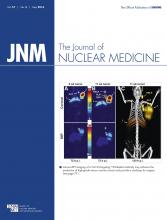Supplemental breast cancer screening: Fowler provides perspective on the advantages and challenges of molecular screening approaches, such as breast-specific γ-imaging, in women with increased breast cancer risk and previews a related article in this issue of JNM.
Page 661
c-MET visualization: Pool and colleagues look at promising approaches and tracers in development for PET and PET/CT imaging targeting c-MET–expressing tumors and introduce an article on this topic in this issue of JNM.
Page 663
90Y microspheres for colorectal metastases: Hickey and colleagues report on survival and safety outcomes in a large cohort of patients with colorectal liver metastases treated with glass-based 90Y microspheres.
Page 665
68Ga-alfatide II in NSCLC and TB: Kang and colleagues compare the diagnostic potential of this new RGD-based angiogenesis tracer with that of 18F-FDG in PET/CT differentiation of non–small cell lung cancer from lung tuberculosis.
Page 672
BSGI detection of breast cancer: Brem and colleagues look at increases in disease detection when breast-specific γ-imaging is used as an adjunct to mammography in women at increased risk for breast cancer.
Page 678
Thyroid cancer and breast cancer risk: Lin and colleagues investigate the risk of breast cancer in patients with thyroid cancer and include analyses of the effects of 131I treatment or nontreatment on this risk.
Page 685
PET and esophageal cancer response: van Rossum and colleagues determine whether subjective and quantitative assessment of baseline 18F-FDG PET can improve accuracy in predicting pathologic complete response to preoperative chemoradiotherapy in esophageal cancer.
Page 691
124I PET/CT and recurrent thyroid cancer: Kist and colleagues describe a prospective multicenter cohort study designed to test the hypothesis that 124I PET/CT can identify patients who will have tumor-negative 131I whole-body scintigraphy after 131I therapy.
Page 701
68Ga-DOTATATE toxicity and efficacy: Deppen and colleagues evaluate the safety and efficacy of 68Ga-DOTATATE PET/CT for diagnosis, staging, and restaging of pulmonary and gastroenteropancreatic neuroendocrine tumors and compare these results with those from 111In-pentetreotide imaging.
Page 708
GLP-1R PET/CT and insulinomas: Luo and colleagues compare the effectiveness of glucagon-like peptide-1 receptor PET/CT using 68Ga-NOTA-exendin-4 with that of SPECT/CT, MR, and ultrasound imaging in detecting insulinoma in a prospective cohort of patients with endogenous hyperinsulinemic hypoglycemia.
Page 715
18F-FCH PET/CT repeatability: Oprea-Lager and colleagues assess the repeatability of various semiquantitative 18F-fluoromethylcholine parameters in patients with histologically proven prostate cancer and lymphatic or hematogenous metastases.
Page 721
18F-FLT PET and lymphoma prognosis: Schöder and colleagues detail the abilities of 18F-FLT and 18F-FDG PET to predict clinical outcomes after R-CHOP-14 therapy in patients with advanced B-cell lymphoma.
Page 728
PET prediction in Ewing sarcoma: O and colleagues detail the prognostic value of early quantitative 18F-FDG PET in monitoring therapy with an antibody to the insulin-like growth factor 1 receptor in patients with Ewing sarcoma–related disease.
Page 735
CXCR4 PET in solid cancers: Vag and colleagues report on the distribution and potential diagnostic value of a novel 68Ga-labeled chemokine receptor–targeted PET probe in patients with solid cancers with in vitro evidence of CXCR4 overexpression.
Page 741
Microfluidic preparation of 89Zr-trastuzumab: Wright and colleagues describe the design and evaluation of a microfluidic reactor capable of synthesizing a single clinical dose of 89Zr-labeled antibody.
Page 747
Lean body mass on PET/CT: Decazes and colleagues evaluate the reliability of a method for estimation of lean body mass for semiquantification of 18F-FDG uptake using data from low-dose CT from PET/CT acquired over standard acquisition fields.
Page 753
Dose deposits in micrometastases: Hindié and colleagues compare the effectiveness of 90Y, 177Lu, 111In, and 161Tb in irradiating micrometastases, using the Monte Carlo code CELLDOSE to assess electron doses in a range of spheres.
Page 759
c-MET imaging of locoregional recurrence: Arulappu and colleagues assess 18F-AH113804, a peptide-based molecular imaging agent with high affinity for human c-MET, in detection of early-stage locoregional recurrence in a human basal-like breast cancer model.
Page 765
Immuno-PET and ovarian cancer: Sharma and colleagues synthesize an 89Zr-labeled monoclonal antibody targeted to CA125 and evaluate PET imaging and biodistribution in mice bearing human ovarian adenocarcinoma xenografts.
Page 771
SV2A PET NHPs: Nabulsi and colleagues describe synthesis and characterization in nonhuman primates of a PET synaptic vesicle glycoprotein radiotracer with the potential to serve as a biomarker of synaptic density in neurodegenerative disorders.
Page 777
11C-PBR28 rat pharmacokinetics: Parente and colleagues evaluate this second-generation translocator protein tracer as a tool for detection and quantification of neuroinflammation in preclinical studies and compare its imaging properties with those of (R)-11C-PK11195.
Page 785
18F-THK5117 PET in transgenic mice: Brendel and colleagues visualize tau deposition in vivo with the 2-arylquinoline derivative 18F-THK5117 using small-animal PET in conjunction with autoradiography and immunohistochemistry in 2 transgenic mouse models expressing hyperphosphorylated tau.
Page 792
111In-exendin-3 for islet imaging: van der Kroon and colleagues explore imaging of transplanted islets in rats with a small-animal SPECT scanner and 111In-labeled exendin-3 to target the glucagon-like peptide-1 receptor expressed on β-cells.
Page 799
Response evaluation with 99mTc-Duramycin: Elvas and colleagues report on a study designed to validate the use of 99mTc-labeled tetracycline hydrochloride for SPECT imaging of induction of cell death and early response of tumors to treatment.
Page 805
89Zr-AMG 110 PET: Warnders and colleague describe tumor targeting and tissue distribution with this radiolabeled antibody construct that induces T cell–mediated cell death by cross-linking the epithelial cell adhesion molecule with a cluster of differentiation on T cells.
Page 812
Spatial bias in brain PET/MR: Teuho and colleagues investigate spatial bias in brain PET/MR using an anthropomorphic brain phantom in 7 PET/MR and PET/CT systems at 4 institutions.
Page 818
- © 2016 by the Society of Nuclear Medicine and Molecular Imaging, Inc.







